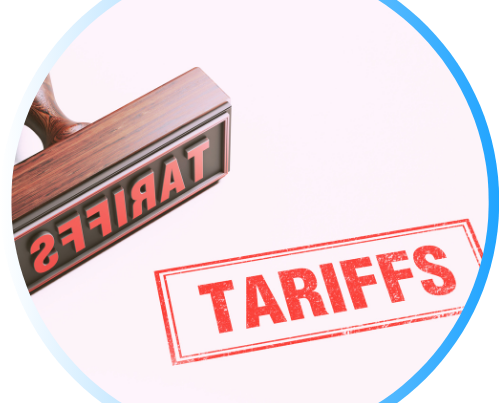Rate Related Update and Market Conditions
📌 Current U.S. Tariff Status (as of October 24, 2025)
-
Potential 155% Tariff on Chinese Goods: On October 21, President Trump confirmed that tariffs on Chinese imports could rise to 155% on November 1 if no trade deal is reached. The current total rate stands at 55% under the existing tariff truce.
-
Rare Earth Export Controls Remain Key Issue: China’s new licensing requirements for rare earth exports and re-exports, announced October 9, remain a major factor in ongoing U.S.–China negotiations ahead of next week’s APEC meeting in South Korea.
-
25% Tariff on Medium- and Heavy-Duty Trucks: Effective November 1, the U.S. will implement a 25% tariff on MHDVs and parts, and a 10% tariff on buses. Imports over 25 years old will be exempt, and USMCA-compliant vehicles may pay duties only on non-U.S. content.
-
100% Duty on Chinese Cargo Equipment: Beginning November 9, the U.S. will apply a 100% duty on Chinese-made ship-to-shore cranes and cargo handling equipment, per a recent USTR notice.
-
Port Fees on Chinese-Operated Vessels: As of October 14, the U.S. has introduced new port fees on Chinese-built and operated vessels, with China enacting reciprocal measures on American ships.
Source: whitehouse.gov, politico.com, whitehouse.gov
Rate Related Update and Market Conditions
Ocean Trade Lane Snapshot
Ocean conditions remain mixed across key east–west routes. On the Trans-Pacific Eastbound (TPEB), capacity is recovering sharply to 84–86% in November following October’s post–Golden Week reduction, though demand has yet to rebound. The October 15 GRI has stabilized rates, with the SCFI up 31.9% to the U.S. West Coast and 16.4% to the East Coast, and carriers have filed another GRI for November 1 while deferring the PSS. On the Far East Westbound (FEWB), carriers continue blank sailings to manage oversupply as demand from Europe lags amid high inventories and weak sentiment. Load factors hover near 80–85%, SCFI levels have steadied after recent declines, and 40’ equipment remains tight in South China. Across the Trans-Atlantic Westbound (TAWB), congestion persists at major European ports—Antwerp, Rotterdam, Hamburg, and Bremerhaven—with yard utilization between 70% and 90% and delays of several days. Equipment shortages continue across Central and Southern Europe, keeping spot rates stable at roughly $1,800–$1,900 per FEU.
Air Freight Market Update
Asia’s air market remains firm with strong momentum led by technology and ecommerce exports from China, Vietnam, and Malaysia. Tight Trans-Pacific space and consistent China-Europe demand continue to support rate stability, while Vietnam and Thailand face capacity pressure as shippers advance seasonal bookings. Korea and India remain steady, though rates are trending modestly upward amid tightening space toward month-end. Overall, conditions remain resilient, and early bookings are recommended to secure uplift and manage costs.
Sources: xeneta.com, maersk.com, yangming.com, evergreen-line.com, supplychaindive.com
Asia–Latin America Freight & Port Update
1) Freight Rate & Capacity Snapshot
Spot pricing on the Far East → South America East Coast lane is broadly steady: the XSI-C reads ~$2,961/FEU today, little changed week to date. Carriers are signaling mild near-term firming via GRIs and new FAK filings into early November, consistent with this week’s uptick on major East–West benchmarks. Expect mostly stable utilization with selective capacity discipline as GRIs land.
Sources: drewry.co.uk ; compassft.com
2) Port Operations & Infrastructure
Brazil’s Port of Santos shows manageable but non-trivial strain (≈1.5 days average vessel wait; yard ~73% utilization). Chile advanced plans for a US$4.45B capacity expansion at San Antonio (targeting ~6M TEU), a medium-term positive for gateway reliability. Meanwhile, weather in parts of China/Vietnam/Philippines caused short closures (16–51 hours at several South China ports), with knock-on schedule risk into LATAM services.
Sources: dredgewire.com.com

Tariffs Recast U.S. Sourcing From China, But Global Box Volumes Still Expand
Despite higher U.S. duties and shifting deadlines, the impact has mainly redirected U.S. imports away from China rather than slowing worldwide trade. An industry analyst notes global container throughput has grown around 6% this year, outperforming typical expectations despite volatility. The data suggests China-origin shipments to the U.S. have eased, but alternative sourcing and resilient demand elsewhere have supported overall volume growth, keeping global container flows on an upward track.
Container Freight Rates Climb for Second Week Amid Carrier GRIs
The Drewry World Container Index rose 3% to $1,746 per forty-foot container this week, reflecting a second consecutive gain after months of decline. Spot rates from Shanghai to Los Angeles and New York climbed 4% and 6%, respectively, as mid-October GRIs took effect. Carriers are introducing new FAK rates of $2,600–$2,700 per forty-foot container on November 1, with another increase planned mid-November. Analysts expect modest short-term gains before supply growth pressures rates later this year.


